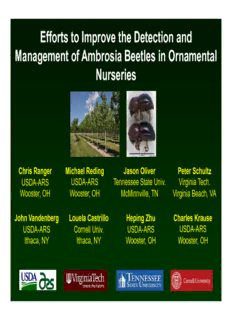
Efforts to Improve the Detection and Management of Ambrosia Beetles in Ornamental Management ... PDF
Preview Efforts to Improve the Detection and Management of Ambrosia Beetles in Ornamental Management ...
Efforts to Improve the Detection and MMaannaaggeemmeenntt ooff AAmmbbrroossiiaa BBeeeettlleess iinn OOrrnnaammeennttaall Nurseries Chris Ranger Michael Reding Jason Oliver Peter Schultz UUSSDDAA-AARRSS UUSSDDAA-AARRSS TTennessee SSttatte UUniiv. VViirgiiniia TTechh. Wooster, OH Wooster, OH McMinnville, TN Virginia Beach, VA JJoohhnn VVaannddeennbbeerrgg LLoouueellaa CCaassttrriilllloo HHeeppiinngg ZZhhuu CChhaarrlleess KKrraauussee USDA-ARS Cornell Univ. USDA-ARS USDA-ARS Ithaca, NY Ithaca, NY Wooster, OH Wooster, OH An Emerging Pest Management Challenge Facing the Industry • Ambrosia beetles Order: Coleoptera Family: Curculionidae Subfamily: Scolytinae Tribe: Xyleborini GGenus: XXyllosanddrus • Extensive economic loss, but not well ddeffiinedd • Wood-boring behavior, thus difficult to detect and control Black Stem Borer Xylosandrus germanus • Introduced from Japan or east Asia -First reported in NY (1932) •• NNoorrtthheeaasstteerrnn, SSoouutthheeaasstteerrnn, Midwestern, Southern, and ♀ Northwestern US Granulate Ambrosia Beetle XXyllosanddrus crassiiuscullus • Introduced from southern Asia -First reported in SC (1974) • Northeastern, Southeastern, ♀ Midwestern, Southern, and Northwestern US, plus Hawaii 2.0mm Hosts for X. germanus and X. crassiusculus • >200 hosts worldwide; deciduous trees preferred -- AAppppllee, CChheerrrryy, CChheessttnnuutt, DDooggwwoooodd, HHyyddrraannggeeaa, GGoollddeenn RRaaiinnttrreeee, Lilac, Magnolia, Maple, Peach, Pear, Redbud, Styrax, Weeping Mulberry, Yellowwood • Typically pests of stressed or dying trees • , But examples of attacks on “apparently healthy” trees too - “Apparently healthy” to whom? Cryptic Tunneling Behavior of Ambrosia Beetles ~2 mm diam. ~~11 mmmm ddiiaamm. X. ggermanus XX.. ccrraassssiiuussccuulluuss Frass Toothpicks = Symptom of an Infestation Cornus Magnolia virginiana Sap Production = Symptom of an Infestation Cornus Styrax Styrax Gallery Formation X. germanus gallery X. germanus in Magnolia virginiana larvae and pupae Ambrosia Beetle Fungal Symbionts USDA-ARS, Wooster, OH X. germanus USDA-ARS, Wooster, OH • Symbiotic fungi maintained iin pouchh ((ii.e., mycangiia)) • Larvae and adults feed on fungi, nott hhostt ttree USDA-ARS, Wooster, OH • Ambrosiella species associated with X. germanus Terminal dieback, basal sprouts = symptoms of an infestation Magnolia virginiana
Description: